Improving Rural Health in Australia: The Nurse's Pivotal Role
VerifiedAdded on 2021/06/18
|15
|2743
|111
Report
AI Summary
This report provides a comprehensive overview of rural health challenges in Australia, highlighting issues such as geographical isolation, lack of funding, and workforce shortages. It examines the role of nurse practitioners in improving health outcomes, discussing the impact of government policies, research findings, and the need for enhanced training and support for rural healthcare professionals. The report analyzes various studies and pilot programs to demonstrate the effectiveness of nurse-led initiatives in palliative care and the importance of addressing stressors and burnout among rural healthcare workers. It also emphasizes the need for improved funding, skill development, and a focus on health promotion activities to enhance the quality of care and access in rural regions. The report draws upon multiple research papers and studies to support its arguments and provide a detailed analysis of the current state of rural health in Australia.
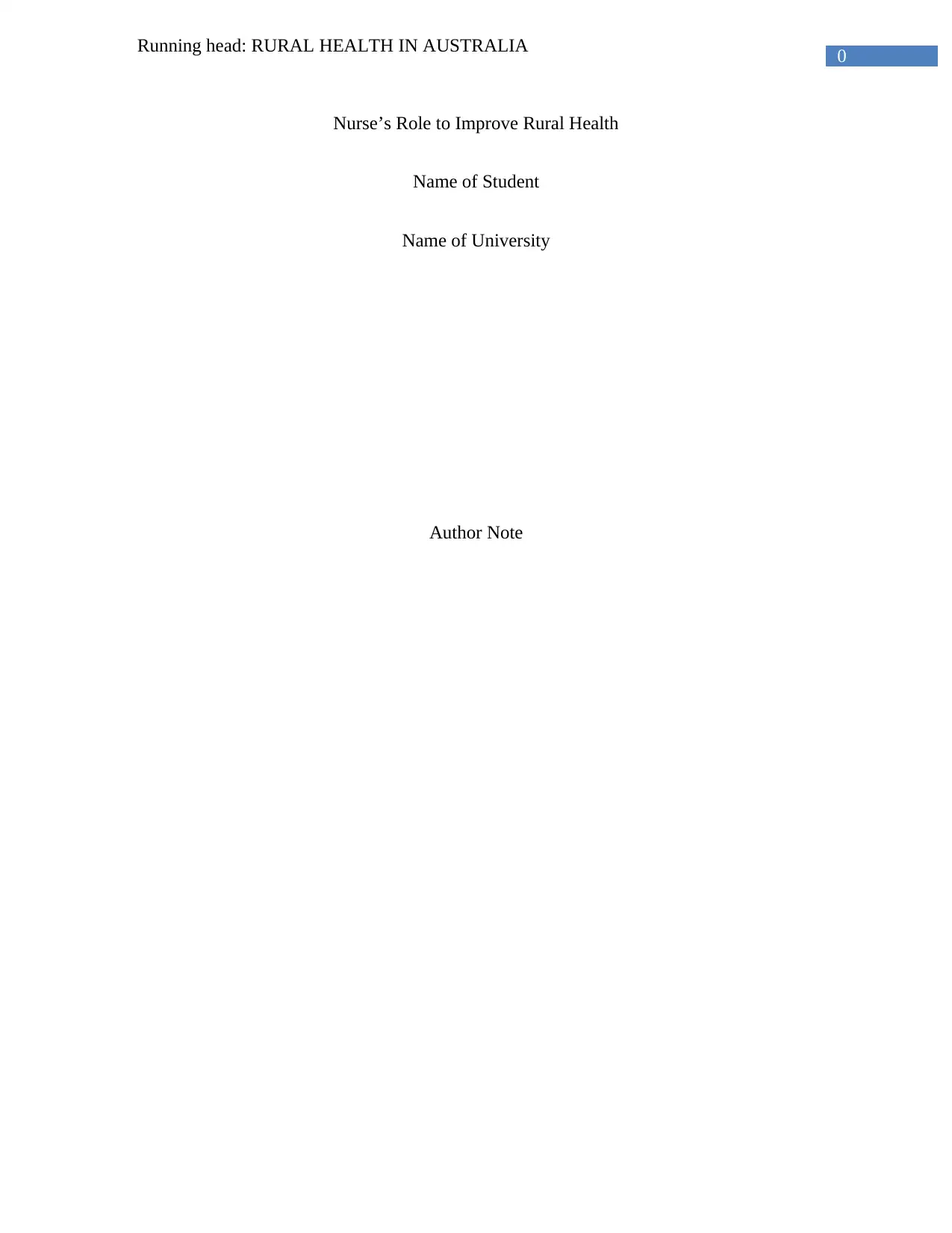
0
Running head: RURAL HEALTH IN AUSTRALIA
Nurse’s Role to Improve Rural Health
Name of Student
Name of University
Author Note
Running head: RURAL HEALTH IN AUSTRALIA
Nurse’s Role to Improve Rural Health
Name of Student
Name of University
Author Note
Paraphrase This Document
Need a fresh take? Get an instant paraphrase of this document with our AI Paraphraser
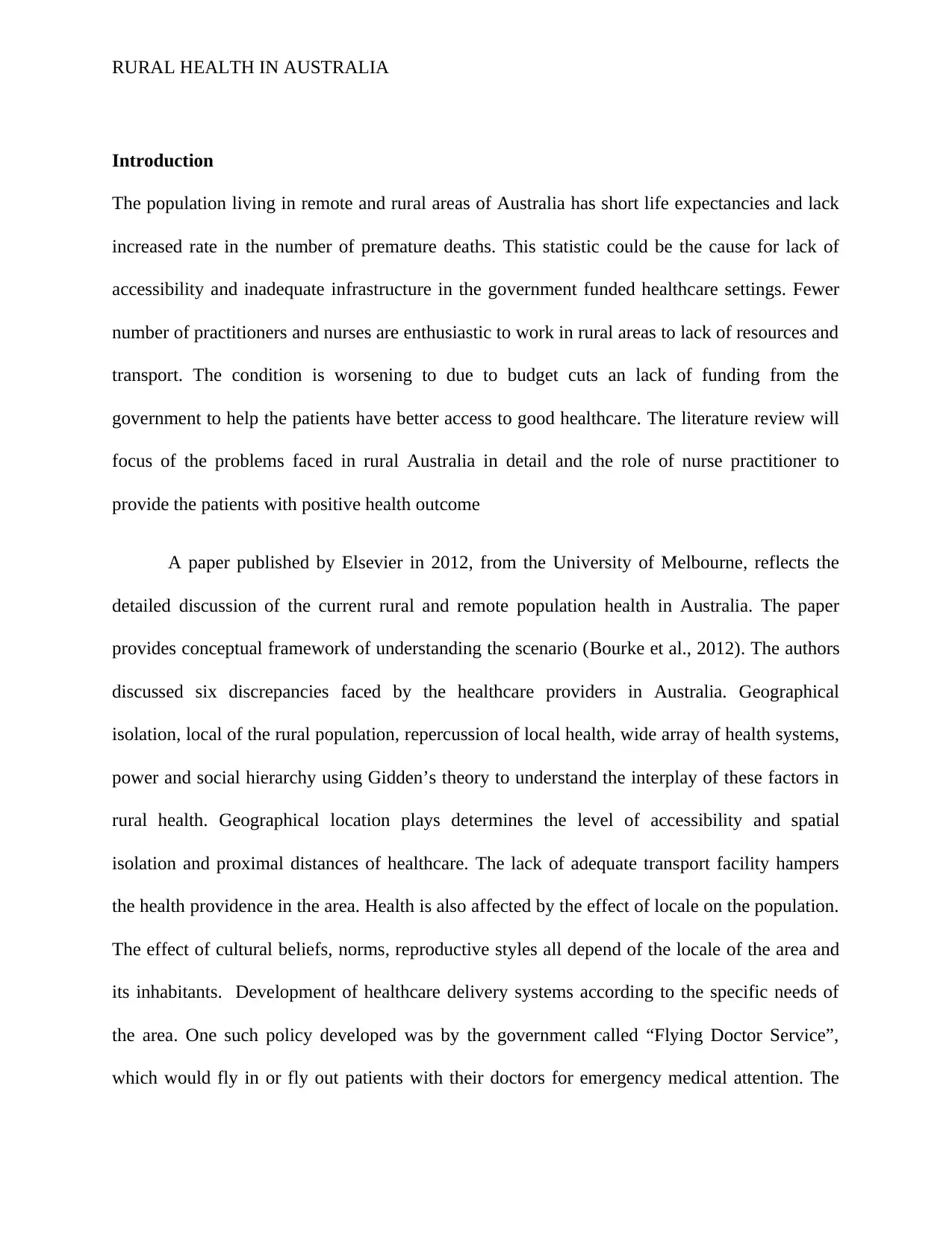
RURAL HEALTH IN AUSTRALIA
Introduction
The population living in remote and rural areas of Australia has short life expectancies and lack
increased rate in the number of premature deaths. This statistic could be the cause for lack of
accessibility and inadequate infrastructure in the government funded healthcare settings. Fewer
number of practitioners and nurses are enthusiastic to work in rural areas to lack of resources and
transport. The condition is worsening to due to budget cuts an lack of funding from the
government to help the patients have better access to good healthcare. The literature review will
focus of the problems faced in rural Australia in detail and the role of nurse practitioner to
provide the patients with positive health outcome
A paper published by Elsevier in 2012, from the University of Melbourne, reflects the
detailed discussion of the current rural and remote population health in Australia. The paper
provides conceptual framework of understanding the scenario (Bourke et al., 2012). The authors
discussed six discrepancies faced by the healthcare providers in Australia. Geographical
isolation, local of the rural population, repercussion of local health, wide array of health systems,
power and social hierarchy using Gidden’s theory to understand the interplay of these factors in
rural health. Geographical location plays determines the level of accessibility and spatial
isolation and proximal distances of healthcare. The lack of adequate transport facility hampers
the health providence in the area. Health is also affected by the effect of locale on the population.
The effect of cultural beliefs, norms, reproductive styles all depend of the locale of the area and
its inhabitants. Development of healthcare delivery systems according to the specific needs of
the area. One such policy developed was by the government called “Flying Doctor Service”,
which would fly in or fly out patients with their doctors for emergency medical attention. The
Introduction
The population living in remote and rural areas of Australia has short life expectancies and lack
increased rate in the number of premature deaths. This statistic could be the cause for lack of
accessibility and inadequate infrastructure in the government funded healthcare settings. Fewer
number of practitioners and nurses are enthusiastic to work in rural areas to lack of resources and
transport. The condition is worsening to due to budget cuts an lack of funding from the
government to help the patients have better access to good healthcare. The literature review will
focus of the problems faced in rural Australia in detail and the role of nurse practitioner to
provide the patients with positive health outcome
A paper published by Elsevier in 2012, from the University of Melbourne, reflects the
detailed discussion of the current rural and remote population health in Australia. The paper
provides conceptual framework of understanding the scenario (Bourke et al., 2012). The authors
discussed six discrepancies faced by the healthcare providers in Australia. Geographical
isolation, local of the rural population, repercussion of local health, wide array of health systems,
power and social hierarchy using Gidden’s theory to understand the interplay of these factors in
rural health. Geographical location plays determines the level of accessibility and spatial
isolation and proximal distances of healthcare. The lack of adequate transport facility hampers
the health providence in the area. Health is also affected by the effect of locale on the population.
The effect of cultural beliefs, norms, reproductive styles all depend of the locale of the area and
its inhabitants. Development of healthcare delivery systems according to the specific needs of
the area. One such policy developed was by the government called “Flying Doctor Service”,
which would fly in or fly out patients with their doctors for emergency medical attention. The
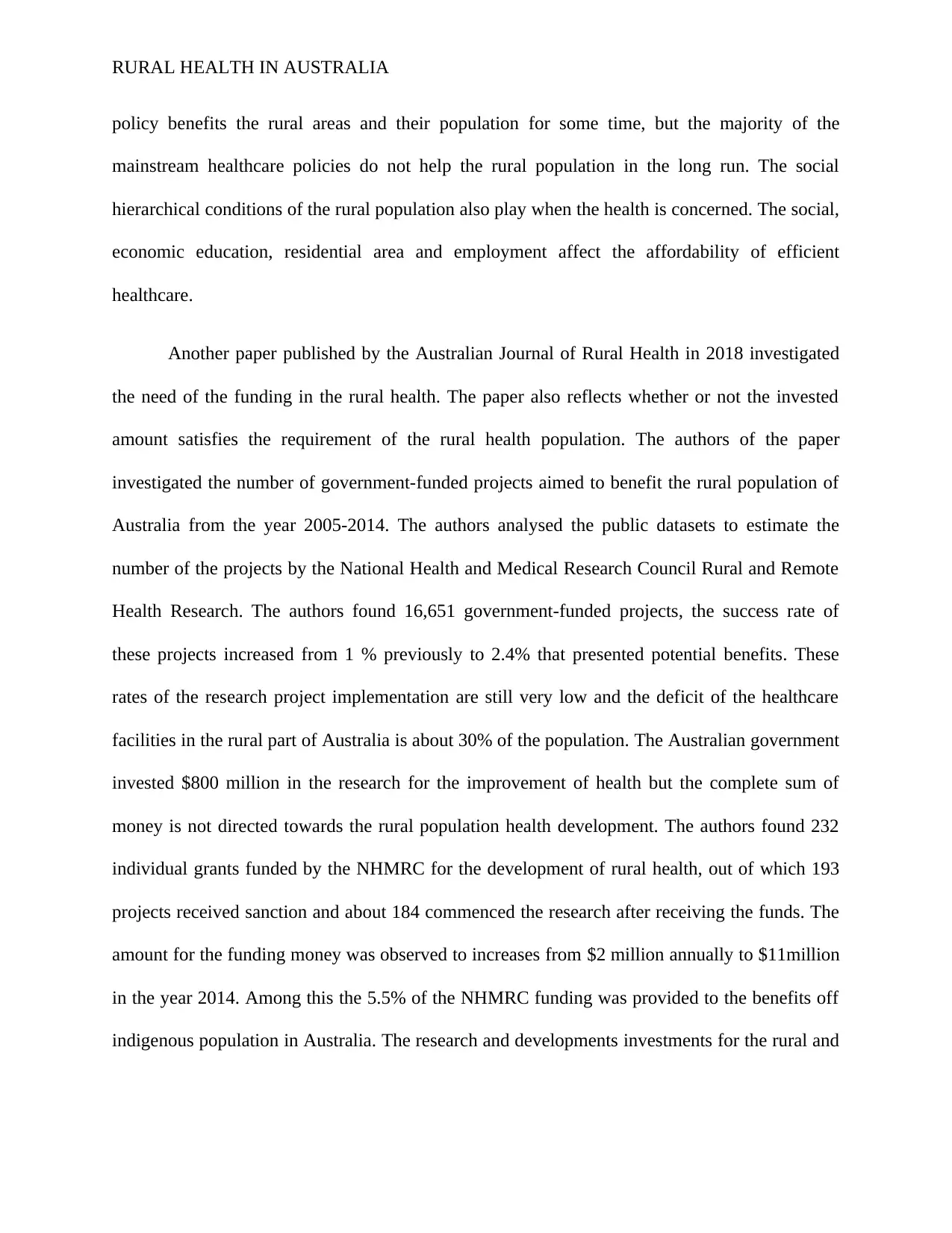
RURAL HEALTH IN AUSTRALIA
policy benefits the rural areas and their population for some time, but the majority of the
mainstream healthcare policies do not help the rural population in the long run. The social
hierarchical conditions of the rural population also play when the health is concerned. The social,
economic education, residential area and employment affect the affordability of efficient
healthcare.
Another paper published by the Australian Journal of Rural Health in 2018 investigated
the need of the funding in the rural health. The paper also reflects whether or not the invested
amount satisfies the requirement of the rural health population. The authors of the paper
investigated the number of government-funded projects aimed to benefit the rural population of
Australia from the year 2005-2014. The authors analysed the public datasets to estimate the
number of the projects by the National Health and Medical Research Council Rural and Remote
Health Research. The authors found 16,651 government-funded projects, the success rate of
these projects increased from 1 % previously to 2.4% that presented potential benefits. These
rates of the research project implementation are still very low and the deficit of the healthcare
facilities in the rural part of Australia is about 30% of the population. The Australian government
invested $800 million in the research for the improvement of health but the complete sum of
money is not directed towards the rural population health development. The authors found 232
individual grants funded by the NHMRC for the development of rural health, out of which 193
projects received sanction and about 184 commenced the research after receiving the funds. The
amount for the funding money was observed to increases from $2 million annually to $11million
in the year 2014. Among this the 5.5% of the NHMRC funding was provided to the benefits off
indigenous population in Australia. The research and developments investments for the rural and
policy benefits the rural areas and their population for some time, but the majority of the
mainstream healthcare policies do not help the rural population in the long run. The social
hierarchical conditions of the rural population also play when the health is concerned. The social,
economic education, residential area and employment affect the affordability of efficient
healthcare.
Another paper published by the Australian Journal of Rural Health in 2018 investigated
the need of the funding in the rural health. The paper also reflects whether or not the invested
amount satisfies the requirement of the rural health population. The authors of the paper
investigated the number of government-funded projects aimed to benefit the rural population of
Australia from the year 2005-2014. The authors analysed the public datasets to estimate the
number of the projects by the National Health and Medical Research Council Rural and Remote
Health Research. The authors found 16,651 government-funded projects, the success rate of
these projects increased from 1 % previously to 2.4% that presented potential benefits. These
rates of the research project implementation are still very low and the deficit of the healthcare
facilities in the rural part of Australia is about 30% of the population. The Australian government
invested $800 million in the research for the improvement of health but the complete sum of
money is not directed towards the rural population health development. The authors found 232
individual grants funded by the NHMRC for the development of rural health, out of which 193
projects received sanction and about 184 commenced the research after receiving the funds. The
amount for the funding money was observed to increases from $2 million annually to $11million
in the year 2014. Among this the 5.5% of the NHMRC funding was provided to the benefits off
indigenous population in Australia. The research and developments investments for the rural and
⊘ This is a preview!⊘
Do you want full access?
Subscribe today to unlock all pages.

Trusted by 1+ million students worldwide
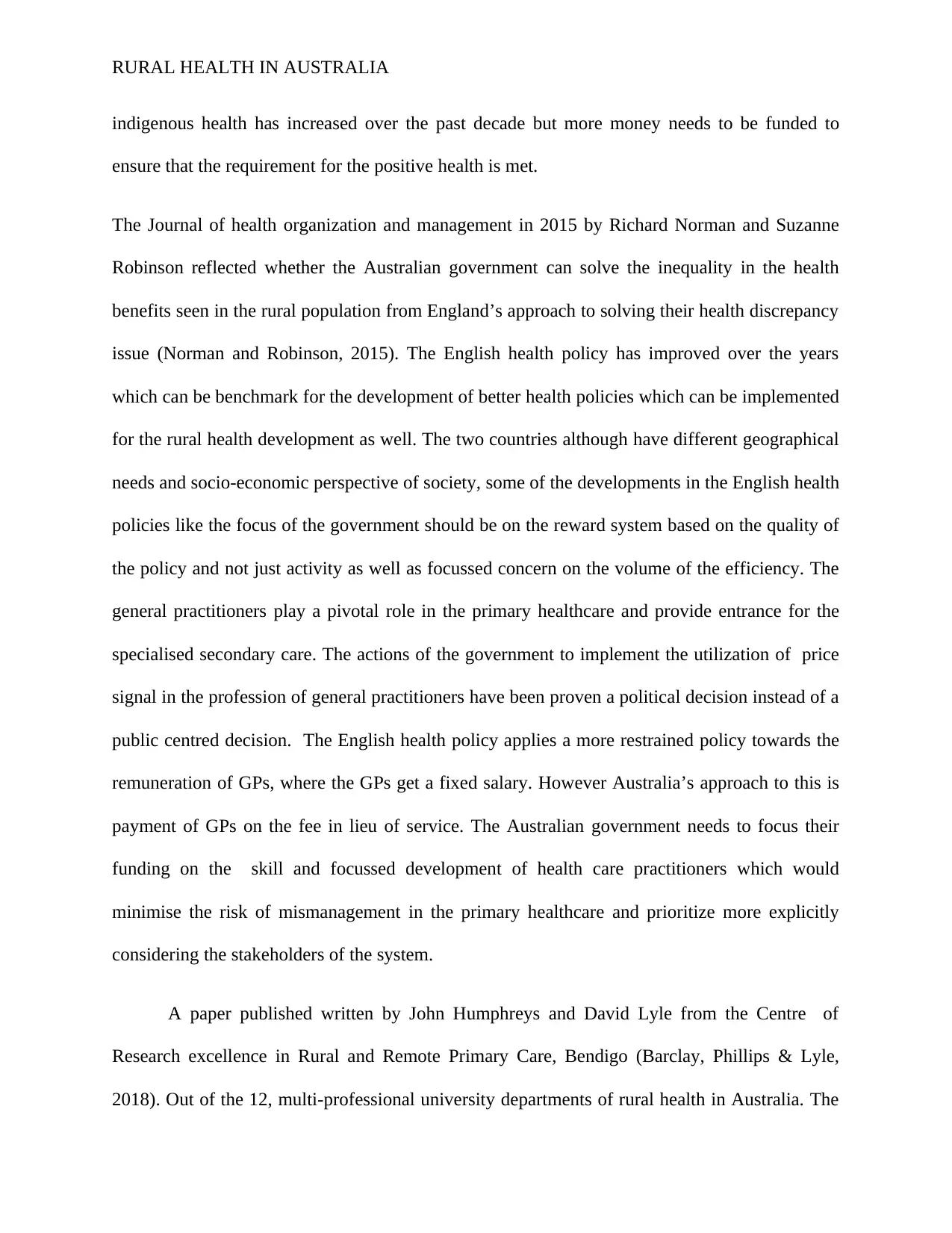
RURAL HEALTH IN AUSTRALIA
indigenous health has increased over the past decade but more money needs to be funded to
ensure that the requirement for the positive health is met.
The Journal of health organization and management in 2015 by Richard Norman and Suzanne
Robinson reflected whether the Australian government can solve the inequality in the health
benefits seen in the rural population from England’s approach to solving their health discrepancy
issue (Norman and Robinson, 2015). The English health policy has improved over the years
which can be benchmark for the development of better health policies which can be implemented
for the rural health development as well. The two countries although have different geographical
needs and socio-economic perspective of society, some of the developments in the English health
policies like the focus of the government should be on the reward system based on the quality of
the policy and not just activity as well as focussed concern on the volume of the efficiency. The
general practitioners play a pivotal role in the primary healthcare and provide entrance for the
specialised secondary care. The actions of the government to implement the utilization of price
signal in the profession of general practitioners have been proven a political decision instead of a
public centred decision. The English health policy applies a more restrained policy towards the
remuneration of GPs, where the GPs get a fixed salary. However Australia’s approach to this is
payment of GPs on the fee in lieu of service. The Australian government needs to focus their
funding on the skill and focussed development of health care practitioners which would
minimise the risk of mismanagement in the primary healthcare and prioritize more explicitly
considering the stakeholders of the system.
A paper published written by John Humphreys and David Lyle from the Centre of
Research excellence in Rural and Remote Primary Care, Bendigo (Barclay, Phillips & Lyle,
2018). Out of the 12, multi-professional university departments of rural health in Australia. The
indigenous health has increased over the past decade but more money needs to be funded to
ensure that the requirement for the positive health is met.
The Journal of health organization and management in 2015 by Richard Norman and Suzanne
Robinson reflected whether the Australian government can solve the inequality in the health
benefits seen in the rural population from England’s approach to solving their health discrepancy
issue (Norman and Robinson, 2015). The English health policy has improved over the years
which can be benchmark for the development of better health policies which can be implemented
for the rural health development as well. The two countries although have different geographical
needs and socio-economic perspective of society, some of the developments in the English health
policies like the focus of the government should be on the reward system based on the quality of
the policy and not just activity as well as focussed concern on the volume of the efficiency. The
general practitioners play a pivotal role in the primary healthcare and provide entrance for the
specialised secondary care. The actions of the government to implement the utilization of price
signal in the profession of general practitioners have been proven a political decision instead of a
public centred decision. The English health policy applies a more restrained policy towards the
remuneration of GPs, where the GPs get a fixed salary. However Australia’s approach to this is
payment of GPs on the fee in lieu of service. The Australian government needs to focus their
funding on the skill and focussed development of health care practitioners which would
minimise the risk of mismanagement in the primary healthcare and prioritize more explicitly
considering the stakeholders of the system.
A paper published written by John Humphreys and David Lyle from the Centre of
Research excellence in Rural and Remote Primary Care, Bendigo (Barclay, Phillips & Lyle,
2018). Out of the 12, multi-professional university departments of rural health in Australia. The
Paraphrase This Document
Need a fresh take? Get an instant paraphrase of this document with our AI Paraphraser
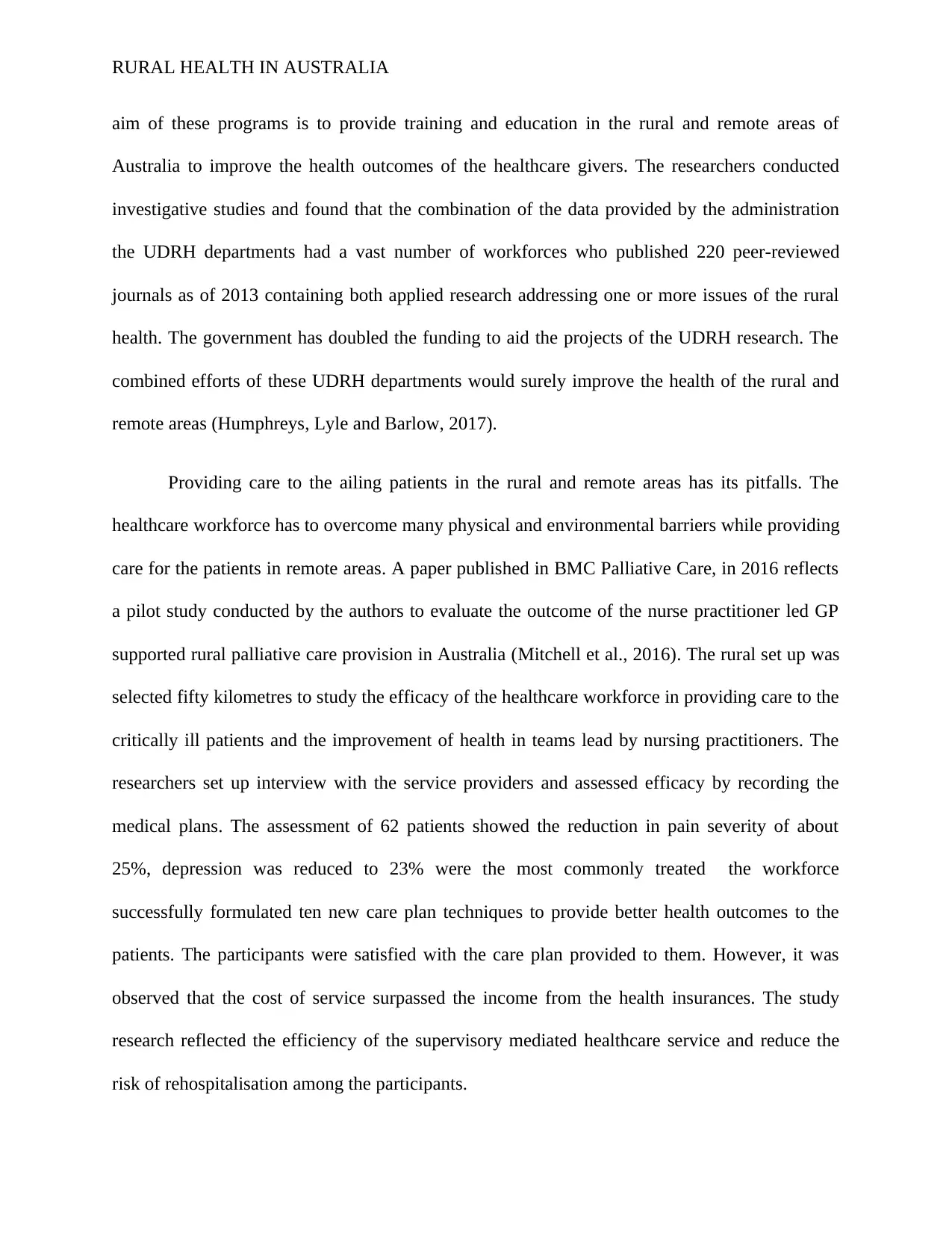
RURAL HEALTH IN AUSTRALIA
aim of these programs is to provide training and education in the rural and remote areas of
Australia to improve the health outcomes of the healthcare givers. The researchers conducted
investigative studies and found that the combination of the data provided by the administration
the UDRH departments had a vast number of workforces who published 220 peer-reviewed
journals as of 2013 containing both applied research addressing one or more issues of the rural
health. The government has doubled the funding to aid the projects of the UDRH research. The
combined efforts of these UDRH departments would surely improve the health of the rural and
remote areas (Humphreys, Lyle and Barlow, 2017).
Providing care to the ailing patients in the rural and remote areas has its pitfalls. The
healthcare workforce has to overcome many physical and environmental barriers while providing
care for the patients in remote areas. A paper published in BMC Palliative Care, in 2016 reflects
a pilot study conducted by the authors to evaluate the outcome of the nurse practitioner led GP
supported rural palliative care provision in Australia (Mitchell et al., 2016). The rural set up was
selected fifty kilometres to study the efficacy of the healthcare workforce in providing care to the
critically ill patients and the improvement of health in teams lead by nursing practitioners. The
researchers set up interview with the service providers and assessed efficacy by recording the
medical plans. The assessment of 62 patients showed the reduction in pain severity of about
25%, depression was reduced to 23% were the most commonly treated the workforce
successfully formulated ten new care plan techniques to provide better health outcomes to the
patients. The participants were satisfied with the care plan provided to them. However, it was
observed that the cost of service surpassed the income from the health insurances. The study
research reflected the efficiency of the supervisory mediated healthcare service and reduce the
risk of rehospitalisation among the participants.
aim of these programs is to provide training and education in the rural and remote areas of
Australia to improve the health outcomes of the healthcare givers. The researchers conducted
investigative studies and found that the combination of the data provided by the administration
the UDRH departments had a vast number of workforces who published 220 peer-reviewed
journals as of 2013 containing both applied research addressing one or more issues of the rural
health. The government has doubled the funding to aid the projects of the UDRH research. The
combined efforts of these UDRH departments would surely improve the health of the rural and
remote areas (Humphreys, Lyle and Barlow, 2017).
Providing care to the ailing patients in the rural and remote areas has its pitfalls. The
healthcare workforce has to overcome many physical and environmental barriers while providing
care for the patients in remote areas. A paper published in BMC Palliative Care, in 2016 reflects
a pilot study conducted by the authors to evaluate the outcome of the nurse practitioner led GP
supported rural palliative care provision in Australia (Mitchell et al., 2016). The rural set up was
selected fifty kilometres to study the efficacy of the healthcare workforce in providing care to the
critically ill patients and the improvement of health in teams lead by nursing practitioners. The
researchers set up interview with the service providers and assessed efficacy by recording the
medical plans. The assessment of 62 patients showed the reduction in pain severity of about
25%, depression was reduced to 23% were the most commonly treated the workforce
successfully formulated ten new care plan techniques to provide better health outcomes to the
patients. The participants were satisfied with the care plan provided to them. However, it was
observed that the cost of service surpassed the income from the health insurances. The study
research reflected the efficiency of the supervisory mediated healthcare service and reduce the
risk of rehospitalisation among the participants.
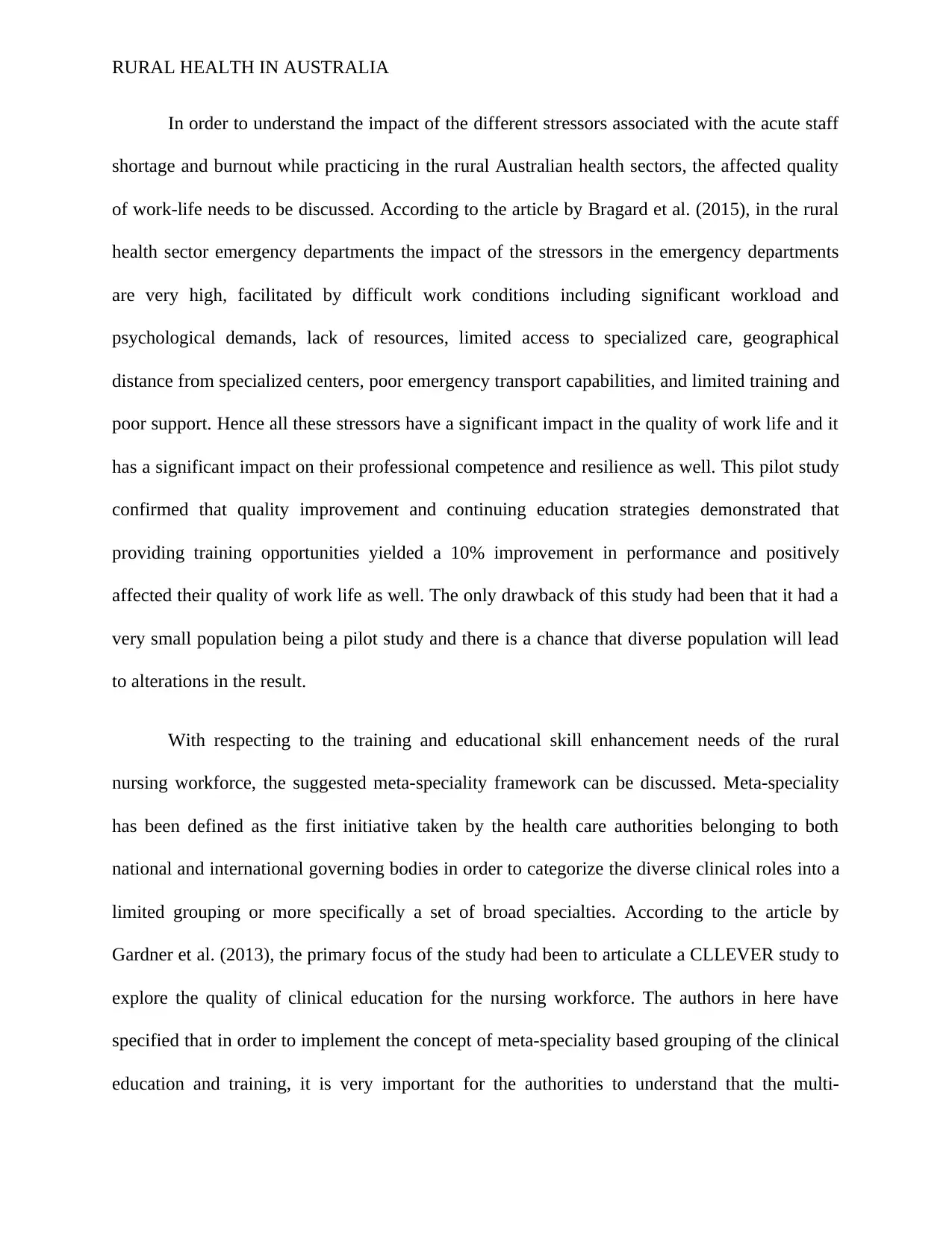
RURAL HEALTH IN AUSTRALIA
In order to understand the impact of the different stressors associated with the acute staff
shortage and burnout while practicing in the rural Australian health sectors, the affected quality
of work-life needs to be discussed. According to the article by Bragard et al. (2015), in the rural
health sector emergency departments the impact of the stressors in the emergency departments
are very high, facilitated by difficult work conditions including significant workload and
psychological demands, lack of resources, limited access to specialized care, geographical
distance from specialized centers, poor emergency transport capabilities, and limited training and
poor support. Hence all these stressors have a significant impact in the quality of work life and it
has a significant impact on their professional competence and resilience as well. This pilot study
confirmed that quality improvement and continuing education strategies demonstrated that
providing training opportunities yielded a 10% improvement in performance and positively
affected their quality of work life as well. The only drawback of this study had been that it had a
very small population being a pilot study and there is a chance that diverse population will lead
to alterations in the result.
With respecting to the training and educational skill enhancement needs of the rural
nursing workforce, the suggested meta-speciality framework can be discussed. Meta-speciality
has been defined as the first initiative taken by the health care authorities belonging to both
national and international governing bodies in order to categorize the diverse clinical roles into a
limited grouping or more specifically a set of broad specialties. According to the article by
Gardner et al. (2013), the primary focus of the study had been to articulate a CLLEVER study to
explore the quality of clinical education for the nursing workforce. The authors in here have
specified that in order to implement the concept of meta-speciality based grouping of the clinical
education and training, it is very important for the authorities to understand that the multi-
In order to understand the impact of the different stressors associated with the acute staff
shortage and burnout while practicing in the rural Australian health sectors, the affected quality
of work-life needs to be discussed. According to the article by Bragard et al. (2015), in the rural
health sector emergency departments the impact of the stressors in the emergency departments
are very high, facilitated by difficult work conditions including significant workload and
psychological demands, lack of resources, limited access to specialized care, geographical
distance from specialized centers, poor emergency transport capabilities, and limited training and
poor support. Hence all these stressors have a significant impact in the quality of work life and it
has a significant impact on their professional competence and resilience as well. This pilot study
confirmed that quality improvement and continuing education strategies demonstrated that
providing training opportunities yielded a 10% improvement in performance and positively
affected their quality of work life as well. The only drawback of this study had been that it had a
very small population being a pilot study and there is a chance that diverse population will lead
to alterations in the result.
With respecting to the training and educational skill enhancement needs of the rural
nursing workforce, the suggested meta-speciality framework can be discussed. Meta-speciality
has been defined as the first initiative taken by the health care authorities belonging to both
national and international governing bodies in order to categorize the diverse clinical roles into a
limited grouping or more specifically a set of broad specialties. According to the article by
Gardner et al. (2013), the primary focus of the study had been to articulate a CLLEVER study to
explore the quality of clinical education for the nursing workforce. The authors in here have
specified that in order to implement the concept of meta-speciality based grouping of the clinical
education and training, it is very important for the authorities to understand that the multi-
⊘ This is a preview!⊘
Do you want full access?
Subscribe today to unlock all pages.

Trusted by 1+ million students worldwide
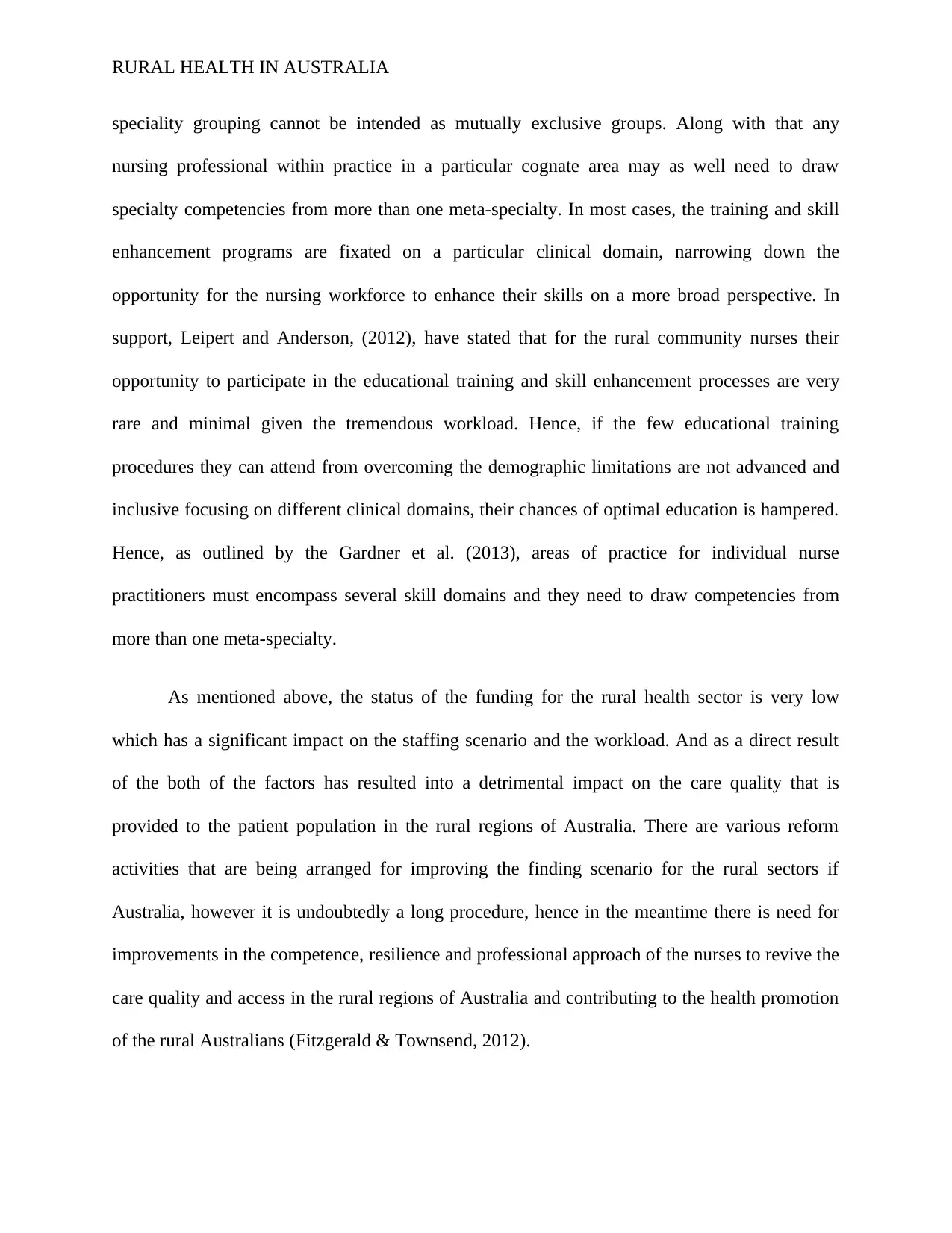
RURAL HEALTH IN AUSTRALIA
speciality grouping cannot be intended as mutually exclusive groups. Along with that any
nursing professional within practice in a particular cognate area may as well need to draw
specialty competencies from more than one meta-specialty. In most cases, the training and skill
enhancement programs are fixated on a particular clinical domain, narrowing down the
opportunity for the nursing workforce to enhance their skills on a more broad perspective. In
support, Leipert and Anderson, (2012), have stated that for the rural community nurses their
opportunity to participate in the educational training and skill enhancement processes are very
rare and minimal given the tremendous workload. Hence, if the few educational training
procedures they can attend from overcoming the demographic limitations are not advanced and
inclusive focusing on different clinical domains, their chances of optimal education is hampered.
Hence, as outlined by the Gardner et al. (2013), areas of practice for individual nurse
practitioners must encompass several skill domains and they need to draw competencies from
more than one meta-specialty.
As mentioned above, the status of the funding for the rural health sector is very low
which has a significant impact on the staffing scenario and the workload. And as a direct result
of the both of the factors has resulted into a detrimental impact on the care quality that is
provided to the patient population in the rural regions of Australia. There are various reform
activities that are being arranged for improving the finding scenario for the rural sectors if
Australia, however it is undoubtedly a long procedure, hence in the meantime there is need for
improvements in the competence, resilience and professional approach of the nurses to revive the
care quality and access in the rural regions of Australia and contributing to the health promotion
of the rural Australians (Fitzgerald & Townsend, 2012).
speciality grouping cannot be intended as mutually exclusive groups. Along with that any
nursing professional within practice in a particular cognate area may as well need to draw
specialty competencies from more than one meta-specialty. In most cases, the training and skill
enhancement programs are fixated on a particular clinical domain, narrowing down the
opportunity for the nursing workforce to enhance their skills on a more broad perspective. In
support, Leipert and Anderson, (2012), have stated that for the rural community nurses their
opportunity to participate in the educational training and skill enhancement processes are very
rare and minimal given the tremendous workload. Hence, if the few educational training
procedures they can attend from overcoming the demographic limitations are not advanced and
inclusive focusing on different clinical domains, their chances of optimal education is hampered.
Hence, as outlined by the Gardner et al. (2013), areas of practice for individual nurse
practitioners must encompass several skill domains and they need to draw competencies from
more than one meta-specialty.
As mentioned above, the status of the funding for the rural health sector is very low
which has a significant impact on the staffing scenario and the workload. And as a direct result
of the both of the factors has resulted into a detrimental impact on the care quality that is
provided to the patient population in the rural regions of Australia. There are various reform
activities that are being arranged for improving the finding scenario for the rural sectors if
Australia, however it is undoubtedly a long procedure, hence in the meantime there is need for
improvements in the competence, resilience and professional approach of the nurses to revive the
care quality and access in the rural regions of Australia and contributing to the health promotion
of the rural Australians (Fitzgerald & Townsend, 2012).
Paraphrase This Document
Need a fresh take? Get an instant paraphrase of this document with our AI Paraphraser
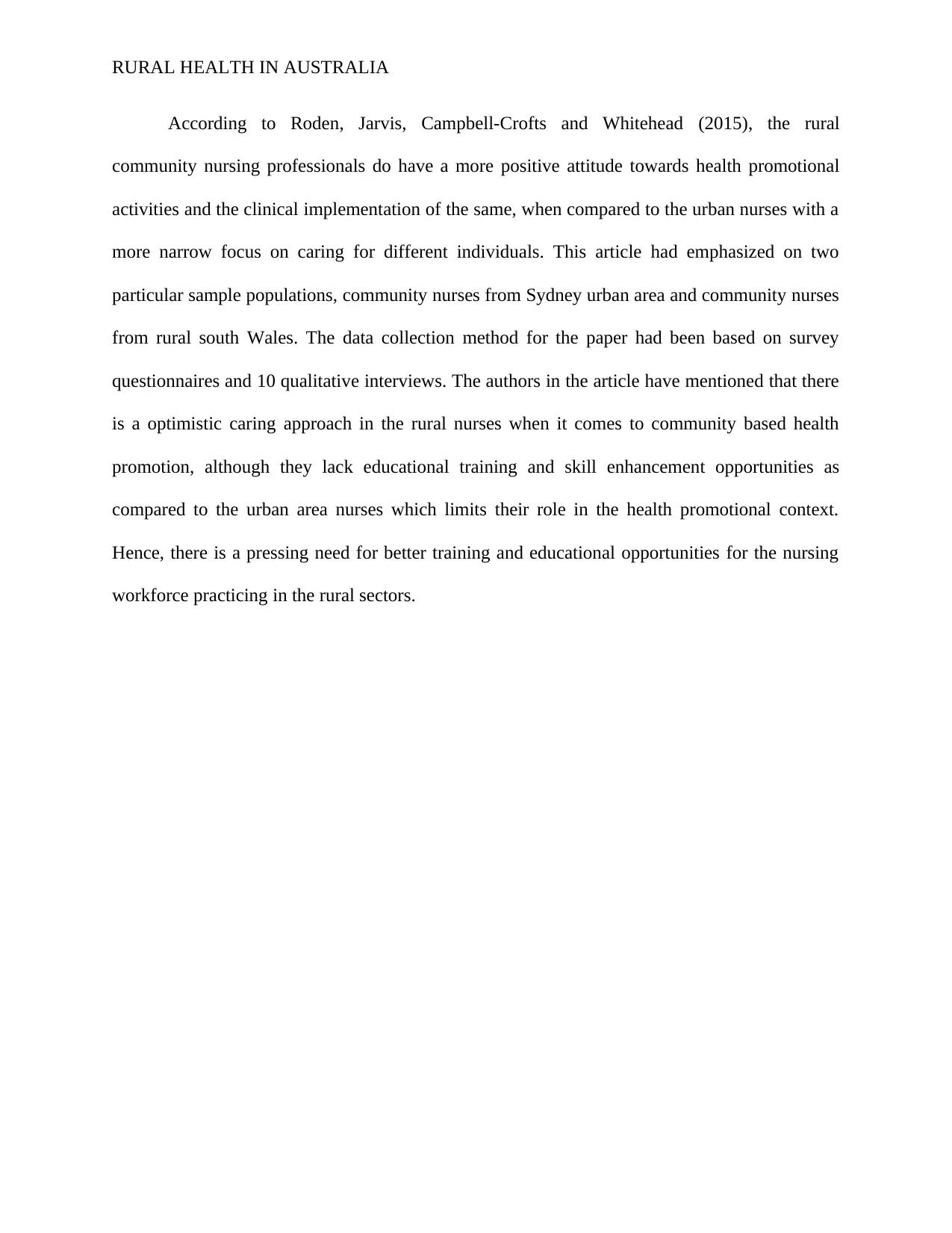
RURAL HEALTH IN AUSTRALIA
According to Roden, Jarvis, Campbell-Crofts and Whitehead (2015), the rural
community nursing professionals do have a more positive attitude towards health promotional
activities and the clinical implementation of the same, when compared to the urban nurses with a
more narrow focus on caring for different individuals. This article had emphasized on two
particular sample populations, community nurses from Sydney urban area and community nurses
from rural south Wales. The data collection method for the paper had been based on survey
questionnaires and 10 qualitative interviews. The authors in the article have mentioned that there
is a optimistic caring approach in the rural nurses when it comes to community based health
promotion, although they lack educational training and skill enhancement opportunities as
compared to the urban area nurses which limits their role in the health promotional context.
Hence, there is a pressing need for better training and educational opportunities for the nursing
workforce practicing in the rural sectors.
According to Roden, Jarvis, Campbell-Crofts and Whitehead (2015), the rural
community nursing professionals do have a more positive attitude towards health promotional
activities and the clinical implementation of the same, when compared to the urban nurses with a
more narrow focus on caring for different individuals. This article had emphasized on two
particular sample populations, community nurses from Sydney urban area and community nurses
from rural south Wales. The data collection method for the paper had been based on survey
questionnaires and 10 qualitative interviews. The authors in the article have mentioned that there
is a optimistic caring approach in the rural nurses when it comes to community based health
promotion, although they lack educational training and skill enhancement opportunities as
compared to the urban area nurses which limits their role in the health promotional context.
Hence, there is a pressing need for better training and educational opportunities for the nursing
workforce practicing in the rural sectors.
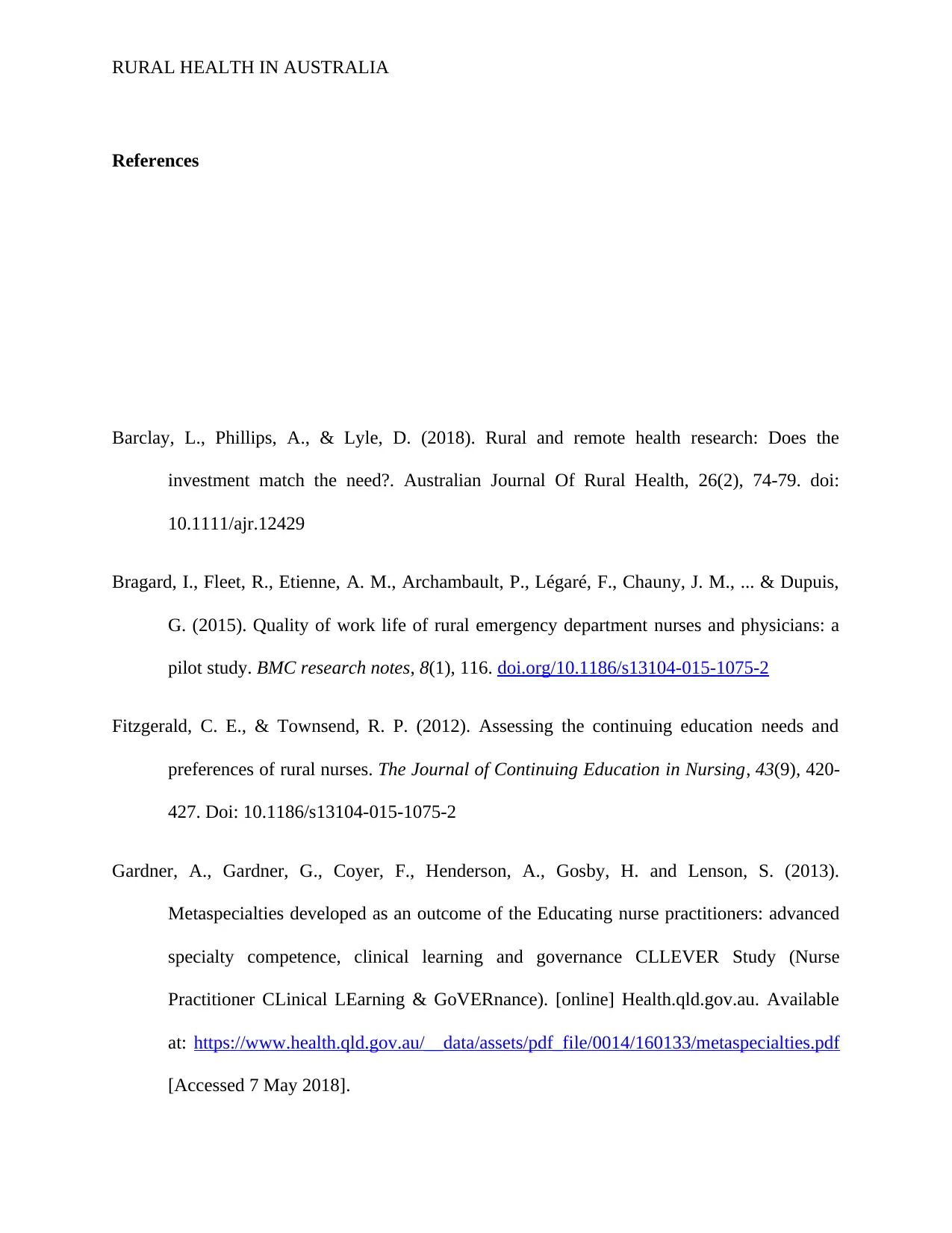
RURAL HEALTH IN AUSTRALIA
References
Barclay, L., Phillips, A., & Lyle, D. (2018). Rural and remote health research: Does the
investment match the need?. Australian Journal Of Rural Health, 26(2), 74-79. doi:
10.1111/ajr.12429
Bragard, I., Fleet, R., Etienne, A. M., Archambault, P., Légaré, F., Chauny, J. M., ... & Dupuis,
G. (2015). Quality of work life of rural emergency department nurses and physicians: a
pilot study. BMC research notes, 8(1), 116. doi.org/10.1186/s13104-015-1075-2
Fitzgerald, C. E., & Townsend, R. P. (2012). Assessing the continuing education needs and
preferences of rural nurses. The Journal of Continuing Education in Nursing, 43(9), 420-
427. Doi: 10.1186/s13104-015-1075-2
Gardner, A., Gardner, G., Coyer, F., Henderson, A., Gosby, H. and Lenson, S. (2013).
Metaspecialties developed as an outcome of the Educating nurse practitioners: advanced
specialty competence, clinical learning and governance CLLEVER Study (Nurse
Practitioner CLinical LEarning & GoVERnance). [online] Health.qld.gov.au. Available
at: https://www.health.qld.gov.au/__data/assets/pdf_file/0014/160133/metaspecialties.pdf
[Accessed 7 May 2018].
References
Barclay, L., Phillips, A., & Lyle, D. (2018). Rural and remote health research: Does the
investment match the need?. Australian Journal Of Rural Health, 26(2), 74-79. doi:
10.1111/ajr.12429
Bragard, I., Fleet, R., Etienne, A. M., Archambault, P., Légaré, F., Chauny, J. M., ... & Dupuis,
G. (2015). Quality of work life of rural emergency department nurses and physicians: a
pilot study. BMC research notes, 8(1), 116. doi.org/10.1186/s13104-015-1075-2
Fitzgerald, C. E., & Townsend, R. P. (2012). Assessing the continuing education needs and
preferences of rural nurses. The Journal of Continuing Education in Nursing, 43(9), 420-
427. Doi: 10.1186/s13104-015-1075-2
Gardner, A., Gardner, G., Coyer, F., Henderson, A., Gosby, H. and Lenson, S. (2013).
Metaspecialties developed as an outcome of the Educating nurse practitioners: advanced
specialty competence, clinical learning and governance CLLEVER Study (Nurse
Practitioner CLinical LEarning & GoVERnance). [online] Health.qld.gov.au. Available
at: https://www.health.qld.gov.au/__data/assets/pdf_file/0014/160133/metaspecialties.pdf
[Accessed 7 May 2018].
⊘ This is a preview!⊘
Do you want full access?
Subscribe today to unlock all pages.

Trusted by 1+ million students worldwide
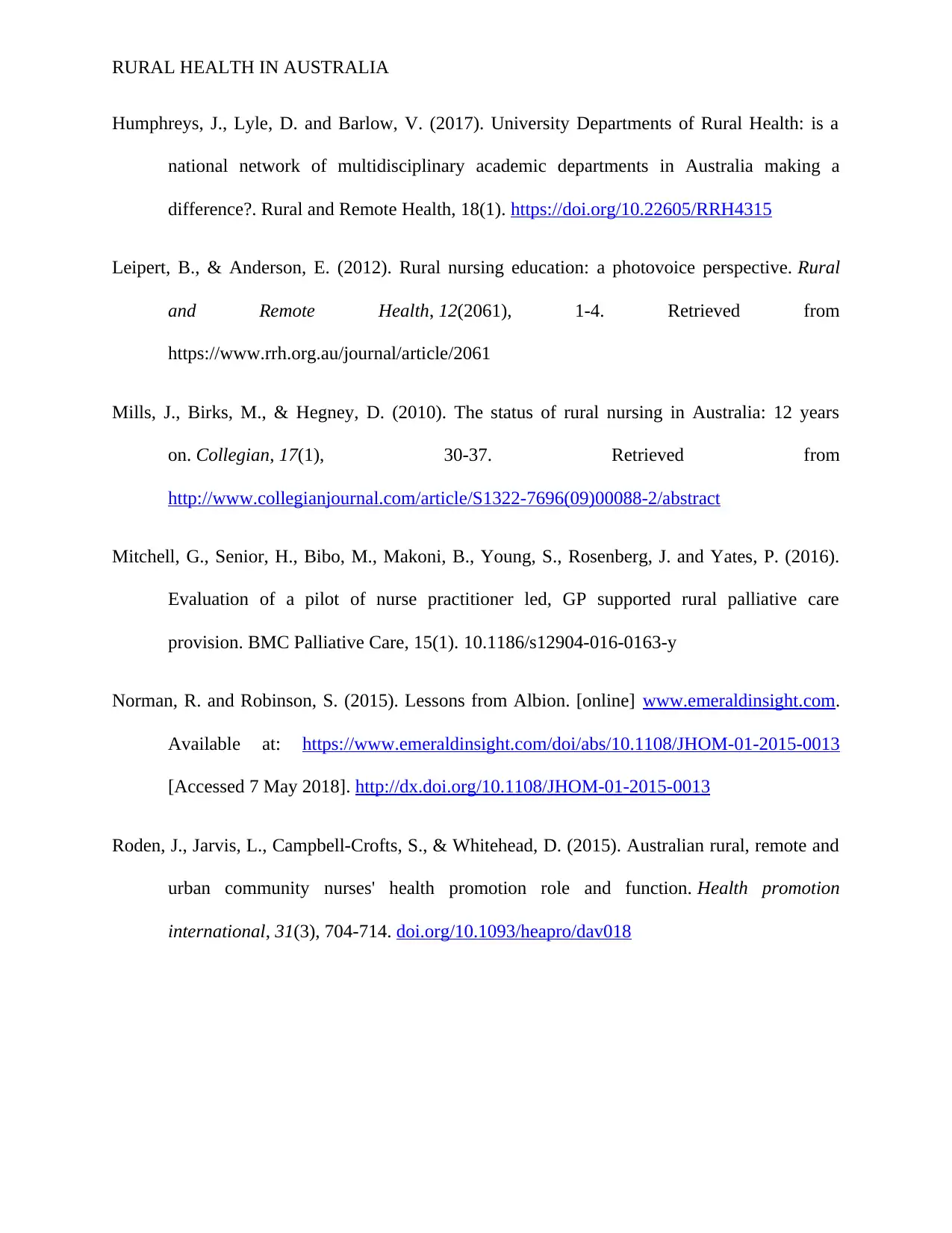
RURAL HEALTH IN AUSTRALIA
Humphreys, J., Lyle, D. and Barlow, V. (2017). University Departments of Rural Health: is a
national network of multidisciplinary academic departments in Australia making a
difference?. Rural and Remote Health, 18(1). https://doi.org/10.22605/RRH4315
Leipert, B., & Anderson, E. (2012). Rural nursing education: a photovoice perspective. Rural
and Remote Health, 12(2061), 1-4. Retrieved from
https://www.rrh.org.au/journal/article/2061
Mills, J., Birks, M., & Hegney, D. (2010). The status of rural nursing in Australia: 12 years
on. Collegian, 17(1), 30-37. Retrieved from
http://www.collegianjournal.com/article/S1322-7696(09)00088-2/abstract
Mitchell, G., Senior, H., Bibo, M., Makoni, B., Young, S., Rosenberg, J. and Yates, P. (2016).
Evaluation of a pilot of nurse practitioner led, GP supported rural palliative care
provision. BMC Palliative Care, 15(1). 10.1186/s12904-016-0163-y
Norman, R. and Robinson, S. (2015). Lessons from Albion. [online] www.emeraldinsight.com.
Available at: https://www.emeraldinsight.com/doi/abs/10.1108/JHOM-01-2015-0013
[Accessed 7 May 2018]. http://dx.doi.org/10.1108/JHOM-01-2015-0013
Roden, J., Jarvis, L., Campbell-Crofts, S., & Whitehead, D. (2015). Australian rural, remote and
urban community nurses' health promotion role and function. Health promotion
international, 31(3), 704-714. doi.org/10.1093/heapro/dav018
Humphreys, J., Lyle, D. and Barlow, V. (2017). University Departments of Rural Health: is a
national network of multidisciplinary academic departments in Australia making a
difference?. Rural and Remote Health, 18(1). https://doi.org/10.22605/RRH4315
Leipert, B., & Anderson, E. (2012). Rural nursing education: a photovoice perspective. Rural
and Remote Health, 12(2061), 1-4. Retrieved from
https://www.rrh.org.au/journal/article/2061
Mills, J., Birks, M., & Hegney, D. (2010). The status of rural nursing in Australia: 12 years
on. Collegian, 17(1), 30-37. Retrieved from
http://www.collegianjournal.com/article/S1322-7696(09)00088-2/abstract
Mitchell, G., Senior, H., Bibo, M., Makoni, B., Young, S., Rosenberg, J. and Yates, P. (2016).
Evaluation of a pilot of nurse practitioner led, GP supported rural palliative care
provision. BMC Palliative Care, 15(1). 10.1186/s12904-016-0163-y
Norman, R. and Robinson, S. (2015). Lessons from Albion. [online] www.emeraldinsight.com.
Available at: https://www.emeraldinsight.com/doi/abs/10.1108/JHOM-01-2015-0013
[Accessed 7 May 2018]. http://dx.doi.org/10.1108/JHOM-01-2015-0013
Roden, J., Jarvis, L., Campbell-Crofts, S., & Whitehead, D. (2015). Australian rural, remote and
urban community nurses' health promotion role and function. Health promotion
international, 31(3), 704-714. doi.org/10.1093/heapro/dav018
Paraphrase This Document
Need a fresh take? Get an instant paraphrase of this document with our AI Paraphraser

RURAL HEALTH IN AUSTRALIA

RURAL HEALTH IN AUSTRALIA
⊘ This is a preview!⊘
Do you want full access?
Subscribe today to unlock all pages.

Trusted by 1+ million students worldwide
1 out of 15
Related Documents
Your All-in-One AI-Powered Toolkit for Academic Success.
+13062052269
info@desklib.com
Available 24*7 on WhatsApp / Email
![[object Object]](/_next/static/media/star-bottom.7253800d.svg)
Unlock your academic potential
Copyright © 2020–2025 A2Z Services. All Rights Reserved. Developed and managed by ZUCOL.




